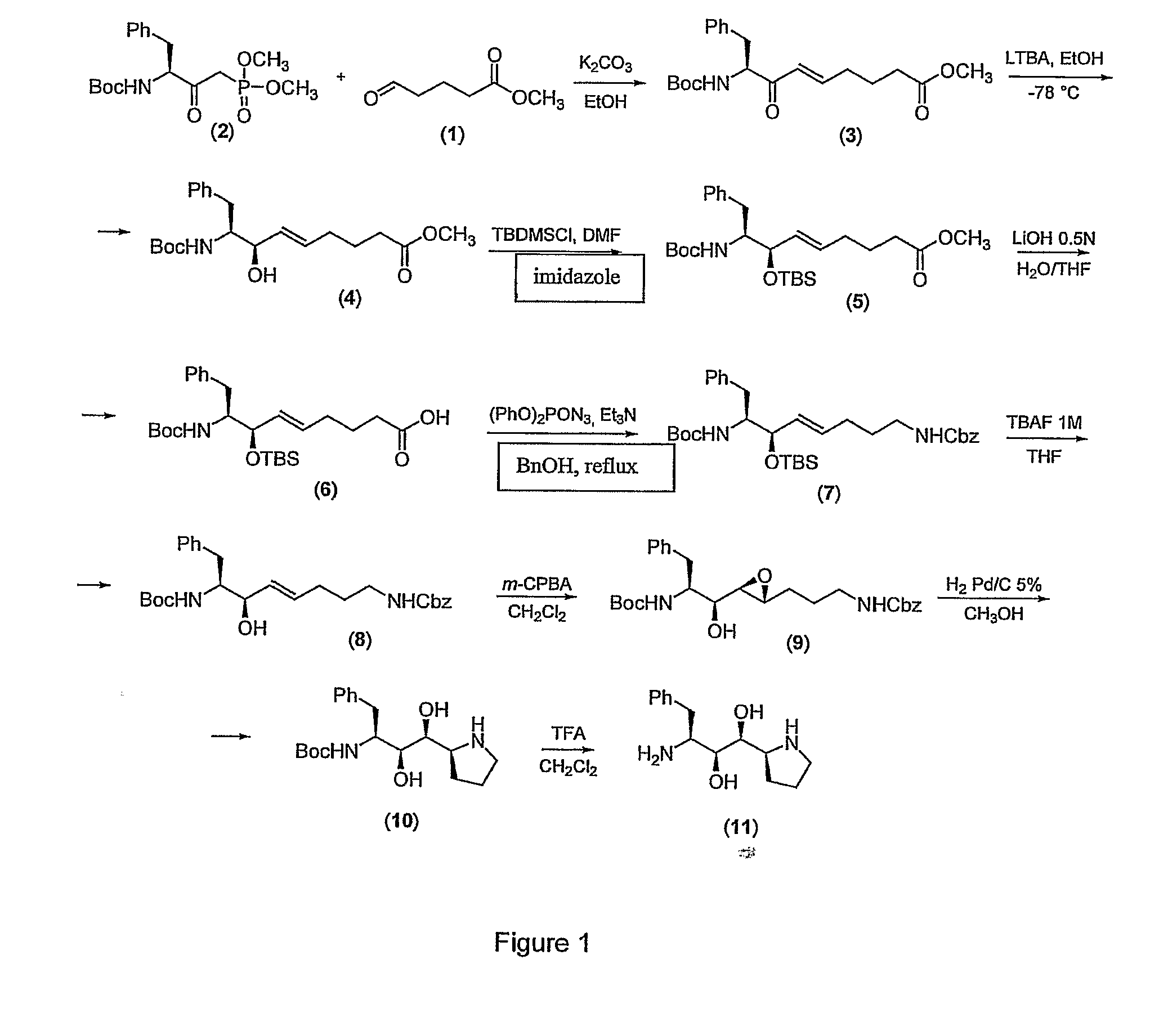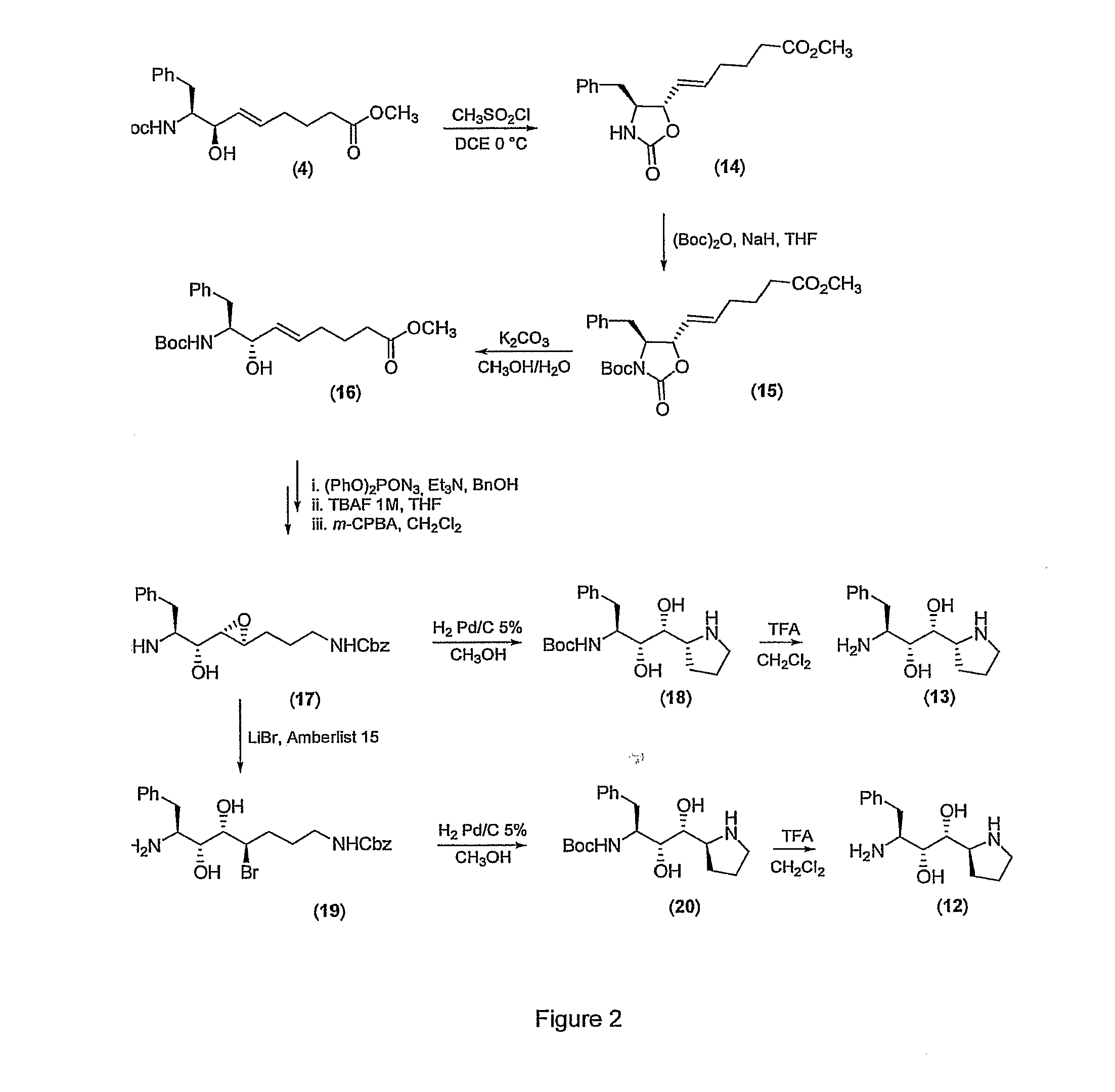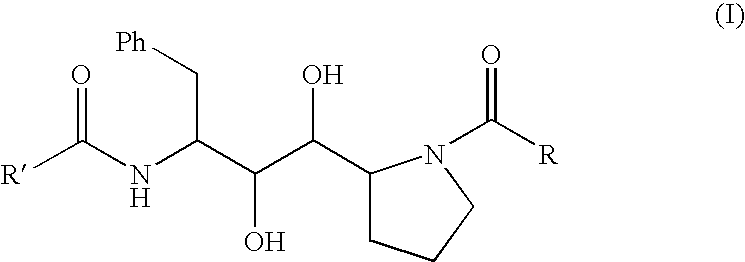Peptidomimetic Inhibitors Of Retroviral Proteases And Their Use As Antivirals
a technology of retroviral proteases and peptidomimetic inhibitors, which is applied in the direction of dipeptide ingredients, tripeptide ingredients, biocides, etc., can solve the problems of reduced solubility, poor bioavailability, and difficult research on substances able to selectively inhibit the replication cycle without damaging the host cell
- Summary
- Abstract
- Description
- Claims
- Application Information
AI Technical Summary
Benefits of technology
Problems solved by technology
Method used
Image
Examples
example 1
Synthesis of the isostere (1S,2S,3S)-3-amino-4-phenyl-1-[(2S)-pyrrolidin-2-yl]butan-1,2-diol (11)
1.a) Preparation of methyl (5E,8S)-8-[(tert-butoxycarbonyl)amino]-7-oxo-9-phenyl-non-5-enoate (3)
[0061] A solution of aldehyde (methyl 5-oxopentanoate) (1) (3.0 g, 23.1 mmol), in absolute ethanol (100 mL) is added, under stirring, to a solution of dimethyl (3S)-3-[(tert-butoxycarbonyl)amino]-2-oxo-4-phenylbutyl-phosphonate (2) (8.58 g, 23.1 mmol) and K2CO3 (3.2 g, 23.1 mmol), dried at 75° C. for 12 hours, in absolute ethanol (200 mL). The mixture is then stirred at room temperature for 16 hours, the solid residue is filtered off and the solution neutralised with glacial acetic acid.
[0062] The solvent is removed under reduced pressure and the residue partitioned between ethyl acetate and a saturated solution of NaHCO3. The aqueous phase is extracted with ethyl acetate (2×50 mL) and the pooled organic phases are washed with a saturated NaCl solution and dried over anhydrous Na2SO4. The...
example 2
Synthesis of the isostere (1S,2S,3S)-3-amino-4-phenyl-1-[(2S)-pyrrolidin-2-yl]butan-1,2-diol (11)
2.a) Synthesis of N-Cbz-pyrrolidinone
[0071] To a solution of 2-pyrrolidinone (1.7 g, 21 mmol) in dry THF (25 mL), at −78° C., a 2.5 N solution of n-buthyllithium in n-hexane (8.4 mL, 21 mmol) is added. The mixture is stirred for 30′ and then a solution of benzyl chlorformate (3.03 mL, 21 mmol) in dry THF (30 mL) is added dropwise. The reaction mixture is stirred until the reaction is complete, quenched with saturated aqueous NH4Cl and ectracted with diethyl ether (3×). The combined organic phase is washed with brine and dried over anhydrous Na2SO4. Evaporation of the solvent gives 4 g (87%) of a colourless oil that is used without any further purification.
2.b) Synthesis of N-Cbz-pyrrolidinol
[0072] N-Cbz-pyrrolidinone (2.79 g, 0.013 mol), prepared following the procedure described at 1.a), is dissolved in 70 mL of freshly distilled methanol and cooled to 0° C. LiBH4 (707 mg, 0.032 m...
example 3
Synthesis of the isostere [(1S,2R,3R)-3-amino-4-phenyl-1-[(2S)-pyrrolidin-2-yl]butan-1,2-diol] (12)
3.a) Preparation of methyl (5E)-6-[(4S,5S)-4-benzyl-2-oxo-1,3-oxazolidin-5-yl]hex-5-enoate (14)
[0078] Triethylamine (2.9 mL, 20.7 mmol) and methanesulfonyl chloride (0.8 mL, 10.3 mmol) are added in the stated order to a solution of the allylic alcohol obtained in example (4) 1.b) (2.6 g, 6.9 mmol) in 1,2 dichloroethane (50 mL), cooled to 0° C. The reaction is monitored by thin layer chromatography (diethyl ether). The mixture is stirred at 0° C. until mesylate formation is complete, then maintained at room temperature until the product has completely formed. The solution is diluted with dichloromethane (50 mL) and washed with cold water, a 10% aqueous solution of cold hydrochloric acid, a saturated NaHCO3 solution, a saturated NaCl solution then dried over anhydrous Na2SO4. The solvent is removed under reduced pressure and the product purified by flash chromatography on a silica gel...
PUM
| Property | Measurement | Unit |
|---|---|---|
| Molar density | aaaaa | aaaaa |
| Molar density | aaaaa | aaaaa |
| Molar density | aaaaa | aaaaa |
Abstract
Description
Claims
Application Information
 Login to View More
Login to View More - R&D
- Intellectual Property
- Life Sciences
- Materials
- Tech Scout
- Unparalleled Data Quality
- Higher Quality Content
- 60% Fewer Hallucinations
Browse by: Latest US Patents, China's latest patents, Technical Efficacy Thesaurus, Application Domain, Technology Topic, Popular Technical Reports.
© 2025 PatSnap. All rights reserved.Legal|Privacy policy|Modern Slavery Act Transparency Statement|Sitemap|About US| Contact US: help@patsnap.com



